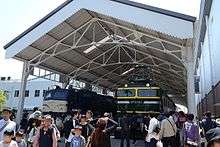JNR Class EF81
|
JR Freight EF81 87, August 2007 | |||||||||||||||||||||||||||
| |||||||||||||||||||||||||||
| |||||||||||||||||||||||||||
| |||||||||||||||||||||||||||
| |||||||||||||||||||||||||||
The Class EF81 is a Bo-Bo-Bo wheel arrangement multi-voltage AC/DC electric locomotive type operated on passenger and freight services in Japan since 1968.[2]
Variants
- EF81-0: Numbers EF81 1 – 152, built 1968–1979
- EF81-300: Numbers EF81 301 – 304, built 1973–1975
- EF81-400: Numbers EF81 401 – 414
- EF81-450: Numbers EF81 451 – 455, built 1991–1992
- EF81-500: Numbers EF81 501 – 503, built 1989
- EF81-600: Former EF81-0 locomotives renumbered by JR Freight from May 2012
EF81-0
152 locomotives were built from 1968 to 1979 in three batches and numbered EF81 1 to EF81 152.[2] 14 EF81-0 locomotives were later modified to become Class EF81-400.[2] The prototype locomotive, EF81 1, was built by Hitachi, and delivered in 1968.[1] Locomotives EF81 137 onward were built with sun-visor plates above the cab windows.[3] These were also subsequently retro-fitted to locomotives EF81 133 to 136.[3]
The prototype, EF81 1, was withdrawn on 31 March 2004.[2]
From May 2012, JR Freight locomotives not fitted with driving recording units mandated for operations over 100 km/h (60 mph) were renumbered by adding "600" to the running number to differentiate them from the other members of the sub-class fitted.[3]
 EF81 2 (first batch) with white stripes indicating refurbishment, March 2008
EF81 2 (first batch) with white stripes indicating refurbishment, March 2008 EF81 92 (second batch) in Cassiopeia livery, September 2007
EF81 92 (second batch) in Cassiopeia livery, September 2007- EF81 142 (third batch)
EF81-300
Four locomotives were built between 1973 and 1975 by Hitachi with unpainted corrugated stainless steel bodies for use on services through the undersea Kanmon Tunnel to Kyushu.[2] In 1978, locomotives EF81 301 and 302 were transferred to the Joban Line in 1978, and received the standard JNR AC/DC livery of pale red.[1]
 EF81 301 in light red livery, August 1992
EF81 301 in light red livery, August 1992 EF81 303, February 2010
EF81 303, February 2010
EF81-400
14 locomotives were built in 1986 and 1987 and to replace ageing Class EF30 hauling services through the Kanmon Tunnel.[2] Although some locomotives operating on a few "Blue Train" services served some railway lines in Kyushu, in particular sections of the Kagoshima Main Line and the Nippō Main Line as well as the entire Nagasaki Main Line.
Locomotives EF81 409 to 414 were withdrawn between March 1996 and December 2010.[4]
 EF81 414 on an Asakaze service, July 1991
EF81 414 on an Asakaze service, July 1991
EF81-450
Five locomotives built in 1991 and 1992 for use hauling freight services through the Kanmon Tunnel. Locomotives EF81 451 and 452 have modern-style headlight clusters.[1]
 EF81 451, September 2006
EF81 451, September 2006 EF81 454, February 2008
EF81 454, February 2008
EF81-500
Three locomotives, EF81 501 to 503, were built by Hitachi in 1989 for JR Freight for use on freight services along the Sea of Japan coastal route.[2]
 EF81 502, August 2010
EF81 502, August 2010
EF81-600
There are former Class EF81-0 locomotives renumbered from May 2012 by JR Freight to differentiate them from locomotives fitted with driving recording units mandated for operations over 100 km/h (60 mph).[3]
 JR Freight EF81 742 and EF81 627, October 2012
JR Freight EF81 742 and EF81 627, October 2012
Livery variations
- JR East EF81 95 in "Super Express Rainbow" livery, February 2007
- JR West EF81 103 in Twilight Express livery, February 2011
 JR East EF81 81 in imperial train livery with silver bodyline stripe, November 2014
JR East EF81 81 in imperial train livery with silver bodyline stripe, November 2014
In August 2014, JR East Tabata-based locomotive EF81 81 was repainted into a JNR-period imperial train locomotive livery, consisting of "rose pink" (Red No. 13) with silver bodyside stripe.[5]
Preserved examples
As of April 2016, three members of the class are preserved.
- EF81 10: Preserved at the Hakuba Mini Train Park in Hakuba, Nagano (front section only).[6]
- EF81 63: Kept at JR Freight's training centre in Shinagawa, Tokyo. (Not on public display)[6]
- EF81 103: Preserved at the Kyoto Railway Museum in Twilight Express green livery.[7]
 Twilight Express EF81 103 (right) in the Twilight Plaza zone at the Kyoto Railway Museum in May 2016
Twilight Express EF81 103 (right) in the Twilight Plaza zone at the Kyoto Railway Museum in May 2016
See also
References
- 1 2 3 4 Inoue, Kōichi (1999). 国鉄機関車辞典 [JNR Locomotive Encyclopedia]. Japan: Sankaido. pp. 130–131. ISBN 4-381-10338-6.
- 1 2 3 4 5 6 7 JR全車輌ハンドブック2009 [JR Rolling Stock Handbook 2009]. Japan: Neko Publishing. 2009. pp. 47–51. ISBN 978-4-7770-0836-0.
- 1 2 3 4 JR機関車カタログ [JR Locomotive Catalogue]. Japan: Ikaros Publications Ltd. 20 June 2013. pp. 64–67. ISBN 9784863207271.
- ↑ JR気動車客車編成表 2013 [JR DMU & Coaching Stock Formations - 2013]. Japan: Kotsu Shimbunsha. 30 June 2013. p. 144. ISBN 978-4-330-37813-8.
- ↑ Sekikawa, Takeshi (November 2014). "EF81 81 [田], 往年の塗装で出場" [Tabata-based EF81 81 outshopped in former livery]. Japan Railfan Magazine (in Japanese). Vol. 54 no. 643. Japan: Koyusha Co., Ltd. p. 169.
- 1 2 Sasada, Masahiro (25 November 2014). 国鉄&JR保存車大全2015-2016 [JNR & JR Preserved Rolling Stock Complete Guide 2015-2016] (in Japanese). Tokyo, Japan: Ikaros Publications Ltd. p. 122. ISBN 978-4863209282.
- ↑ 京都鉄道博物館 [Kyoto Railway Museum]. Japan Railfan Magazine (in Japanese). Vol. 56 no. 662. Japan: Koyusha Co., Ltd. June 2016. p. 52-53.
| Wikimedia Commons has media related to JNR EF81. |

